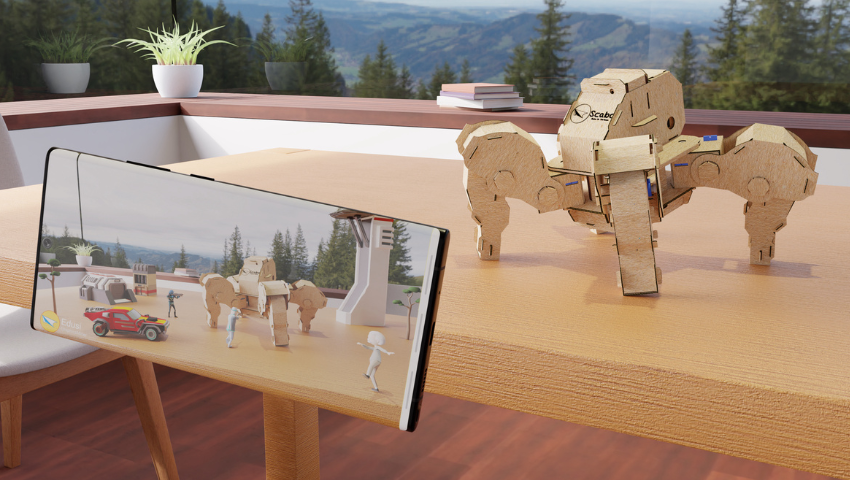Copyright: GraphicsMiner Vietnam
The team from GraphicsMiner provides a new solution to the toy industry, which is eco-friendly and user-friendly. The solution includes both hardware and software: a cardboard robot kit and augmented reality (AR) software platform. This solution brings users a do-it-yourself (DIY) experience of making a legged robot from scratch as well as offering an AR experience. See the presentation in the Experience Hall, 3–5:30 pm PDT on Tuesday, 9 August.
SIGGRAPH: Share some background about your SIGGRAPH 2022 Labs project “Scabo: XR Smart Cardboard Toy Kit.” What inspired it?
Phuong Hoang (PH): Recently, the circular economy has been gaining attention as a potential way for many developing countries in terms of cost-effectiveness and eco-friendly factors. Therefore, our solution should meet the following criteria: recyclability, inexpensiveness, and edutainment.
The main benefit of our solution is to provide 100% recyclable toy kits for children in the Southeast Asia region and the world. The cardboard material can be recycled again after the disposal process. Second, thanks to the cardboard material, the price of the toy kits is reduced significantly, which makes them affordable in most developing countries. Finally, DIY and AR experiences accompany the toy kits. Users can make their toys from scratch and engage in AR games and educational scenarios with the “Scabo” robot.
Our team was inspired by Randy Pausch — an innovator and educator with his work at Disney and Carnegie Mellon University. As we are from Vietnam, we were inspired by Bui Tuong Phong with his pioneering work in computer graphics for Phong shading.
SIGGRAPH: “Scabo” is eco-friendly. Why did you choose to create an environmentally friendly toy? How does “Scabo” contribute to the environmental conversations in our world?
PH: Currently, the production, use, and disposal of fossil fuel-based plastic generates enormous amounts of greenhouse gas (GHG) emissions to our planet. In 2019, the production and incineration of plastic added over 850 million metric tons of greenhouse gases to the atmosphere. By 2050, the cumulation of these greenhouse gas emissions from plastic could reach over 56 gigatons approximately equal to 10–13% of the entire remaining carbon budget. According to the United Nations environment report 2014 “valuing plastics” category, “the toy industry is the most plastic-intensive industry in the world.” Therefore, there is a need to reduce of usage of plastics in all industries, especially the toy industry. “Scabo” will be one of the answers to this quest.
SIGGRAPH: How did you develop the AR software platform? Describe an AR scenario that a user would encounter while playing “Scabo.”
PH: We had been developing a couple of AR scenarios for “Scabo.” Then, we realized that users would love to generate their own AR content. As a consequence, we developed the authoring tool in the AR platform. Users can make up their own universe to challenge their friends. Then, they can play with the “Scabo” robot to conquer other universes. In addition, they can generate their educational AR scenarios. They can talk to the robot to gain more knowledge in scientific subjects with 3D models of human anatomy, animal, mechanics, etc. Last but not least, students in rural areas of developing countries can use the AR platform without an internet connection. Our AR platform is optimized to work seamlessly even with low-end devices since we built the AR platform natively without using common game engines in the market right now.
SIGGRAPH: Why is it important to give users, especially children, the opportunity to build something from scratch?
PH: Our team members all love creating something. We observed and began to understand that many children improve their motor skills while playing or learning. Making the toy kits from scratch can foster those motor skills. By detaching pieces of paper and folding them to construct cardboard toys, children learn how to control their fingers and hands. They also have unlimited choices to paint and decorate their toys.
Second, children can use the AR platform to make up their own virtual scenarios from scratch. We think that their creativity is unlimited, has similarities, and will be inspired with this good tool in their hands.
SIGGRAPH: What do you hope users take away from playing “Scabo”?
PH: The main players in the toy manufacturing industry have not changed the materials used to produce their products in the last 40 years. Our team strongly believes that our cardboard kits will demonstrate the notable example of combining eco-friendly material with augmented reality technologies to transform the toy industry. Our goal is to export products to developing countries in Africa and South America to support educators and learners to utilize AR/MR technologies to enter the metaverse environment for learning and teaching. Then, our next generation will have a better understanding about technologies to reshape our planet in the next couple of decades. In addition, our team is looking for chances to collaborate with other companies to transfer our cardboard toy designs to them in different countries to produce the toy kits. The companies collectively acquire the cardboard disposed by our customers to recycle the products. In the software industry, there is an idiom “write once, run everywhere.” Now in the toy industry, we can say “make once, recycle many times in any country.”
SIGGRAPH: What can SIGGRAPH 2022 participants expect when they experience “Scabo” in the Experience Hall?
PH: Participants can assemble their cardboard toy kits and make it their own by painting it. Then, they can play AR games with the toy kits. “Scabo” is challenging and entertaining for all family members, not just for kids.
SIGGRAPH: SIGGRAPH is excited to host its first in-person conference since 2019 — and first-ever hybrid conference. What are you most looking forward to about the experience?
PH: I am looking forward to seeing the enhanced experiences for hands-free technologies for AR. We learned that many teams are going to allow users to experience their AR glasses at the conference. It will be great to collaborate with the teams to let users to play “Scabo” with a hands-free experience, as we are ready for the next version of the “Scabo.”
Want to learn more about what you’ll experience during Labs? Register to join us in Vancouver or virtually for SIGGRAPH 2022! Now through 11 August, save $30 on new registrations using the code SIGGRAPHSAVINGS. Register now.

Phuong Hoang graduated from Pohang University of Science and Technology (POSTECH), Korea, with a master’s degree in computer science. A founder at GraphicsMiner Lab, he used to work at the POSTTECH Haptics and Virtual Reality Lab. His main research interests are human-computer interaction, physics-based animation and rendering, and Bayesian approaches in machine learning.



